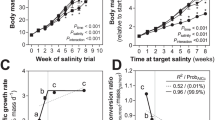Abstract
Condition factor, “K”, was measured for 1202 blacknose dace (Rhinichthys atratulus) from three streams in Shenandoah National Park (USA) of different acid neutralizing capacities (ANCs). “K” is a ratio of weight standardized to length; it is an indication of the health of the individuals in a population. R. atratulus condition factor in the low-ANC stream was found to be significantly lower (11%) than that of dace measured for fish from the intermediate- and high-ANC streams. This difference, according to the results of related investigations, is likely to be biologically significant. Whole-body sodium concentrations were measured as an additional test of sublethal stress in these streams. During summer base flow conditions, mean whole-body sodium concentrations of adult R. atratulus maintained in cages were found to be highest in the low-ANC stream and lowest in the high-ANC stream. The lower condition factor of dace in the low-ANC stream may be related to whole-body sodium concentration and ion regulation. Ion regulation in the low-ANC stream may be more metabolically costly because of chronic sublethal pH stress. R. atratulus may maintain high body Na+ concentrations in low ANC- and ionic strength waters in order to provide a buffer against large episodic pH depressions. The metabolic cost of this ionoregulatory over-compensation may necessitate the diversion of energy from somatic growth and explain the poorer condition of fish from such waters.
Similar content being viewed by others
References
Baker, J.P., and Christensen, S.W.: 1991, “Effects of Acidification on Biological Communities”, In D.F. Charles, Ed. Acidic Deposition and Aquatic Ecosystems, Springer-Verlag, New York, pp. 83–106.
Bulger, A.J.: 1986, Phys. Zool., 59(2), 169–174.
Cosby, B.J., Ryan, F.F., Webb, J.R., Hornberger, G.M., and Galloway, J.N.: 1991, In D.F. Charles, Ed. “Acidic Deposition and Aquatic Ecosystems”, Springer-Verlag, New York, p. 297–318.
Everhart, W.H., and Youngs, W.D.: 1981, “Principles of Fishery Science”, 2nd Edition, Cornell University Press, Ithaca, New York.
Farmer, G.J., and Beamish, F.W.H.: 1969, J. Fish. Rev. Board of Can, 26, 2807–2821.
Gathwright, T.M.: 1976. “Geology of Shenandoah National Park, Virginia”, Bull. 86, Va. Div. of Mineral Resources. 93 pp.
Gibson, J.H., Galloway, J.N., Schofield, C., McFee, W., Johnson, S., McCarely, S., Dise, D., and Herzog, D.: 1983, “Rocky Mountain Acidification Study”, U.S. Fish and Wildlife Service, Division of Biological Services, Eastern Energy and Land Use Team, FWS/OBS-8-/40.17.
Goede, R.W., and Barton, B.A.: 1990, American Fisheries Society Symposium, 8, 80–93.
Grippo, R.S., and Dunson,W.A.: 1991, Arch. Environ. Contam. Toxicol., 21, 289–926.
Lynch, D.D., and Dise, N.B.: 1985. “Sensitivity of Stream Basins in Shenandoah National Park to Acid Deposition”, U.S. Geological Survey, Water-Resources Investigations Report 85-4115.
McAvoy, D.C., Santore, R.C., Shosa, J.D., and Driscoll, C.T.: 1992, Soil Sci. Soc. of Am. J., 56(2), 449–455.
Mills, K.H., Chalanchuk, S.M., Mohr, L.C., and. Davies, I.J.: 1987, Can. J. Fish. Aquat. Sci., 44, 114–125.
NAPAP 1990. “Acidic Deposition: State of Science and Technology. Volume II — Aquatic Processes and Effects”, The U.S. National Acid Precipitation Assessment Program, Government Printing Office, Wash., D.C.
Ryan, P.F., Galloway, J.N., Cosby, B.J., Hornberger, G.M., and Webb, J.R.: 1989, Water Resour. Res., 25, 2091–2099.
Schindler, D.W., Mills, K.H., Malley, D.F., Findlay, D.L., Shearer, J.A, Davies, I.J., Turner, M.A., Linsey, G.A., and Cruikshank, D.R.: 1985, Science, 288, 1395–1401.
Schofield, C.L., and Driscoll, C.T.: 1987, Biogeochem., 3, 63–85.
Webb, J.R., Cosby, B.J., Galloway, J.N., and Hornberger, G.M.: 1989, Water Resour. Res., 25(6), 1367–1377.
Author information
Authors and Affiliations
Rights and permissions
About this article
Cite this article
Dennis, T.E., Bulger, A.J. Condition factor and whole-body sodium concentrations in a freshwater fish: Evidence for acidification stress and possible ionoregulatory over-compensation. Water Air Soil Pollut 85, 377–382 (1995). https://doi.org/10.1007/BF00476858
Issue Date:
DOI: https://doi.org/10.1007/BF00476858




